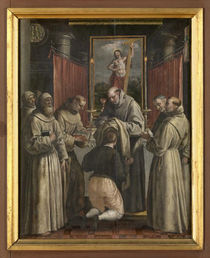The Catholic Defender: Saint Peter of Tarentaise
- Donald Hartley

- May 7
- 2 min read
Updated: May 11

There are two men named Saint Peter of Tarentaise who lived one century apart. The man we honor today is the elder Peter, born in France in the early part of the 12th century. The other man with the same name became Pope Innocent the Fifth.
In 1122, he joined the Cistercians at Bonnevaux and was soon followed by his father and his brothers Lambert and Andrew. His mother and sister joined the Cistercian nuns at Saint Paul d'Izeaux
The Peter we’re focusing on today became a Cistercian monk and eventually served as abbot. In 1142, he was named archbishop of Tarentaise, replacing a bishop who had been deposed because of corruption. Peter tackled his new assignment with vigor. He brought reform into his diocese, replaced lax clergy, and reached out to the poor. He visited all parts of his mountainous diocese on a regular basis.
In 1132, Peter, his abbot, and twelve other monks founded Tamié Abbey in a defile of the Bauges mountains, as a daughter house of Bonnevaux. Once Abbot John was satisfied that the monks had adequate shelter, he returned to Bonnevaux, leaving Peter as abbot of the new monastery. Peter enjoyed humbly serving and conversing with the strangers who sought the hospitality of the monks.
His specific concerns included the welfare of travelers to and from Switzerland and from the Italian cities. He rebuilt a hospice in poor repair at Little St. Bernard Pass. He also founded a charity which distributed food to farms in the surrounding hills. This would become known as pain de Mai and became a tradition continued in the region until the French Revolution. Yet he longed for the simple and pious life of a monk. In 1155 he disappeared and was later found as a lay brother in a remote convent in Switzerland.
On one occasion Pope Eugene III in 1153 asked him to mediate a feud between the lords at La Chambre and the Bishop of Maurienne. Pope Adrian IV also asked him to resolve a dispute between some monks.[6] It was he who upheld Pope Alexander III against Emperor Frederick Barbarossa and the Antipope Victor IV
After about a decade as bishop, Peter “disappeared” for a year and lived quietly as a lay brother at an abbey in Switzerland. When he was found out, the reluctant bishop was persuaded to return to his post. He again focused many of his energies on the poor.
Peter died in 1174 on his way home from an unsuccessful papal assignment to reconcile the kings of France and England. His liturgical feast is celebrated on September 14.
We probably know a lot of people who would welcome the chance to receive some honor or honorary position. They relish the thought of the glamour and glory. But saints like Peter of Tarentaise remind us that humility and the avoidance of glory is the way of the Gospel.
For his charity and healing powers, Peter was viewed as a saint even in his lifetime.[7] His canonization was formalized under Pope Celestine III in 1191.





















Comments